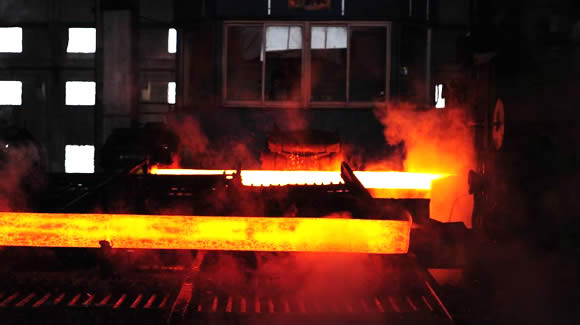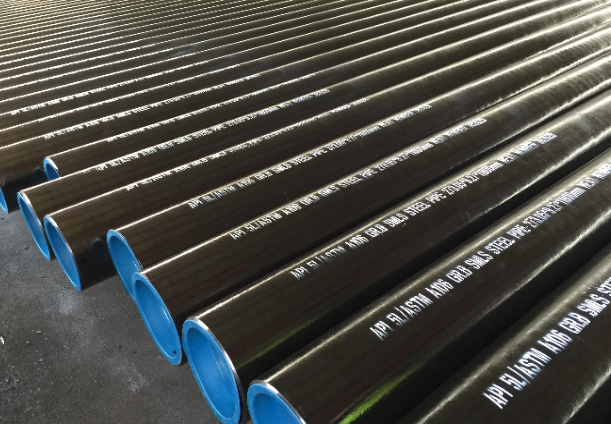
How are Small-caliber Seamless Steel Pipes Made?
How are small-caliber seamless steel pipes made?
①Main production process of hot-rolled seamless steel pipe (△main inspection process):
Tube billet preparation and inspection△→tube billet heating→perforation→pipe rolling→steel pipe reheating→fixed (reduced) diameter→heat treatment△→finished pipe straightening→finishing→inspection△(non-destructive, physical and chemical, bench inspection)→into storage②Main production process of cold-rolled (drawn) seamless steel pipe:
Tube billet preparation → pickling and lubrication → cold rolling (drawing) → heat treatment → straightening → finishing → inspection

The production process of general seamless steel pipes can be divided into two types: cold-drawn and hot-rolled. The production process of cold-rolled seamless steel pipes is generally more complicated than that of hot rolling. In the sizing test, if the surface does not respond to cracks, the pipe must be cut by a cutting machine and cut into a blank of about one meter in length. Then enter the annealing process. Annealing should be pickled with acid liquid. When pickling, pay attention to whether there is a lot of blistering on the surface. If there is a lot of blistering, it means that the quality of the steel pipe does not meet the corresponding standards. In appearance, cold-rolled seamless steel pipes are shorter than hot-rolled seamless steel pipes. The wall thickness of cold-rolled seamless steel pipes is generally smaller than that of hot-rolled seamless steel pipes, but the surface looks brighter than thick-walled seamless steel pipes. Much rough, without too many burrs on the caliber.
The delivery state of hot-rolled seamless steel pipes is generally delivered after heat treatment in the hot-rolled state. After the quality inspection, the hot-rolled seamless steel pipe must be strictly hand-selected by the staff. After the quality inspection, the surface shall be oiled, and then followed by multiple cold drawing experiments. After the hot-rolling treatment, the piercing experiment shall be carried out. , If the perforation is too large, it must be straightened. After straightening, it is transferred by the conveyor to the flaw detector for flaw detection experiment, and finally the label is affixed, the specification is arranged, and then it is placed in the warehouse.
Round tube billet → heating → piercing → three-roll cross rolling, continuous rolling or extrusion → pipe removal → sizing (or reducing) → cooling → straightening → hydraulic test (or flaw detection) → marking → seamless steel pipe in storage The capillary tube is made from steel ingots or solid tube blanks through perforation, and then made by hot rolling, cold rolling or cold drawing. The specifications of seamless steel pipes are expressed in millimeters of outer diameter * wall thickness.

The outer diameter of hot-rolled seamless pipe is generally greater than 32mm and the wall thickness is 2.5-200mm. The outer diameter of cold-rolled seamless pipe can be up to 6mm and the wall thickness can be up to 0.25mm. The outer diameter of thin-walled pipe can be up to 5mm and the wall thickness is less than 0.25mm. Cold rolling has higher dimensional accuracy than hot rolling.
Generally, seamless steel pipes are made of high-quality carbon steels such as 10, 20, 30, 35, 45, low-alloy structural steels such as 16Mn, 5MnV, or 40Cr, 30CrMnSi, 45Mn2, 40MnB, etc., hot-rolled or cold-rolled . Seamless pipes made of low carbon steel such as 10 and 20 are mainly used for fluid transportation pipelines. Seamless pipes made of medium carbon steel such as 45 and 40Cr are used to manufacture mechanical parts, such as stressed parts of automobiles and tractors. Generally, seamless steel pipes must be used for strength and flattening tests. Hot-rolled steel pipes are delivered in hot-rolled state or heat-treated state; cold-rolled steel pipes are delivered in heat-treated state.
Generally, seamless steel pipes are made of high-quality carbon steels such as 10, 20, 30, 35, 45, low-alloy structural steels such as 16Mn, 5MnV, or 40Cr, 30CrMnSi, 45Mn2, 40MnB, etc., hot-rolled or cold-rolled . Seamless pipes made of low carbon steel such as 10 and 20 are mainly used for fluid transportation pipelines. Seamless pipes made of medium carbon steel such as 45 and 40Cr are used to manufacture mechanical parts, such as stressed parts of automobiles and tractors. Generally, seamless steel pipes must be used for strength and flattening tests. Hot-rolled steel pipes are delivered in hot-rolled state or heat-treated state; cold-rolled steel pipes are delivered in heat-treated state.
Hot rolling, as the name implies, the temperature of the rolled piece is high, so the deformation resistance is small, and a large amount of deformation can be achieved. Taking the rolling of steel plate as an example, the thickness of the continuous casting billet is generally about 230mm, and after rough rolling and finishing rolling, the final thickness is 1-20mm. At the same time, due to the small width-to-thickness ratio of the steel plate, the dimensional accuracy requirements are relatively low, and the shape problem is not prone to occur, and the crown is mainly controlled. The requirements for the structure are generally achieved through controlled rolling and controlled cooling, that is, controlling the opening temperature, final rolling temperature and coiling temperature of finishing rolling to control the microstructure and mechanical properties of the strip.
Tips: API 5L X52 seamless pipe is a steel grade of API 5L which specifies the manufacture of two product levels (PSL1 and PSL2) line pipe, X52 Line Pipe can be made seamless or welded, which are widely used as pipeline in the transportation of petroleum and natural gas.


